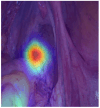A Novel Deep Learning Model for Predicting Colorectal Anastomotic Leakage: A Pioneer Multicenter Transatlantic Study
- PMID: 40807083
- PMCID: PMC12347578
- DOI: 10.3390/jcm14155462
A Novel Deep Learning Model for Predicting Colorectal Anastomotic Leakage: A Pioneer Multicenter Transatlantic Study
Abstract
Background/Objectives: Colorectal anastomotic leak (CAL) is one of the most severe postoperative complications in colorectal surgery, impacting patient morbidity and mortality. Current risk assessment methods rely on clinical and intraoperative factors, but no real-time predictive tool exists. This study aimed to develop an artificial intelligence model based on intraoperative laparoscopic recording of the anastomosis for CAL prediction. Methods: A convolutional neural network (CNN) was trained with annotated frames from colorectal surgery videos across three international high-volume centers (Instituto Português de Oncologia de Lisboa, Hospital das Clínicas de Ribeirão Preto, and Royal Liverpool University Hospital). The dataset included a total of 5356 frames from 26 patients, 2007 with CAL and 3349 showing normal anastomosis. Four CNN architectures (EfficientNetB0, EfficientNetB7, ResNet50, and MobileNetV2) were tested. The models' performance was evaluated using their sensitivity, specificity, accuracy, and area under the receiver operating characteristic (AUROC) curve. Heatmaps were generated to identify key image regions influencing predictions. Results: The best-performing model achieved an accuracy of 99.6%, AUROC of 99.6%, sensitivity of 99.2%, specificity of 100.0%, PPV of 100.0%, and NPV of 98.9%. The model reliably identified CAL-positive frames and provided visual explanations through heatmaps. Conclusions: To our knowledge, this is the first AI model developed to predict CAL using intraoperative video analysis. Its accuracy suggests the potential to redefine surgical decision-making by providing real-time risk assessment. Further refinement with a larger dataset and diverse surgical techniques could enable intraoperative interventions to prevent CAL before it occurs, marking a paradigm shift in colorectal surgery.
Keywords: anastomosis leakage; artificial intelligence; deep learning.
Conflict of interest statement
The authors declare no conflicts of interest.
Figures


Similar articles
-
Development and Validation of a Convolutional Neural Network Model to Predict a Pathologic Fracture in the Proximal Femur Using Abdomen and Pelvis CT Images of Patients With Advanced Cancer.Clin Orthop Relat Res. 2023 Nov 1;481(11):2247-2256. doi: 10.1097/CORR.0000000000002771. Epub 2023 Aug 23. Clin Orthop Relat Res. 2023. PMID: 37615504 Free PMC article.
-
Comparison of Two Modern Survival Prediction Tools, SORG-MLA and METSSS, in Patients With Symptomatic Long-bone Metastases Who Underwent Local Treatment With Surgery Followed by Radiotherapy and With Radiotherapy Alone.Clin Orthop Relat Res. 2024 Dec 1;482(12):2193-2208. doi: 10.1097/CORR.0000000000003185. Epub 2024 Jul 23. Clin Orthop Relat Res. 2024. PMID: 39051924
-
Prescription of Controlled Substances: Benefits and Risks.2025 Jul 6. In: StatPearls [Internet]. Treasure Island (FL): StatPearls Publishing; 2025 Jan–. 2025 Jul 6. In: StatPearls [Internet]. Treasure Island (FL): StatPearls Publishing; 2025 Jan–. PMID: 30726003 Free Books & Documents.
-
The measurement and monitoring of surgical adverse events.Health Technol Assess. 2001;5(22):1-194. doi: 10.3310/hta5220. Health Technol Assess. 2001. PMID: 11532239
-
Signs and symptoms to determine if a patient presenting in primary care or hospital outpatient settings has COVID-19.Cochrane Database Syst Rev. 2022 May 20;5(5):CD013665. doi: 10.1002/14651858.CD013665.pub3. Cochrane Database Syst Rev. 2022. PMID: 35593186 Free PMC article.
References
-
- Kang J., Choi G.-S., Oh J.H., Kim N.K., Park J.S., Kim M.J., Lee K.Y., Baik S.H. Multicenter Analysis of Long-Term Oncologic Impact of Anastomotic Leakage After Laparoscopic Total Mesorectal Excision: The Korean Laparoscopic Colorectal Surgery Study Group. Medicine. 2015;94:e1202. doi: 10.1097/MD.0000000000001202. - DOI - PMC - PubMed
LinkOut - more resources
Full Text Sources

